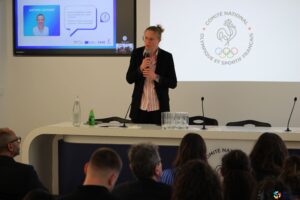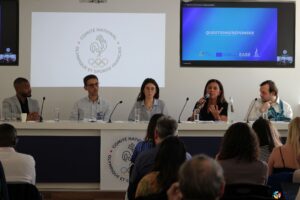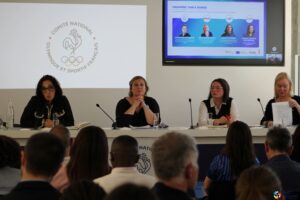On April 1st, 2025, the final conference of the BeST Inclusion project was held at the French National Olympic Committee in Paris. This event brought together experts from across Europe to present the results of two years of work dedicated to making the sport sector more inclusive and representative. The project, co-funded by the European Union and coordinated by EASE, seeks to transform the European sport labour market through the lenses of gender, age, and disability.

Key Messages from the Final Conference
The final event of the BeST Inclusion project, held on April 1st, served not only as a platform to present the results of two years of collaboration but also as a moment of powerful reflection and collective engagement. The afternoon featured two in-depth roundtable discussions bringing together experts from ten organisations, each deeply committed to advancing inclusion in the sport sector. These exchanges were directly linked to the project’s core objectives, with a focus on three critical priorities: gender equality, inclusion of persons with disabilities, and integration of young people into the sport workforce.
The conversations were both inspiring and pragmatic, offering a wide array of perspectives from national and European institutions, grassroots organisations, sport employers, and inclusion specialists.
Among the most impactful takeaways from the conference was the call for a transversal and systemic approach to inclusion. Participants emphasized that real progress depends on embedding inclusive values not only in policy frameworks but also in everyday governance structures and operational practices within sport organisations. Inclusion should not be treated as a peripheral issue—it must be central to the identity and functioning of the sector.
Another key theme was the urgent need to design and implement tailored training and support pathways. To enable underrepresented groups—such as women, persons with disabilities, and youth—to thrive professionally in the sport sector, it is crucial to provide adapted educational resources, mentorship, and accessible career development opportunities. Capacity-building was highlighted as one of the most effective levers for reducing inequalities.
Finally, the role of major sporting events as catalysts for systemic change was widely discussed. Beyond their symbolic value, these events can serve as accelerators for inclusive policy implementation. When designed intentionally, they can generate lasting social impact by embedding inclusion into the very fabric of their planning, staffing, and legacy strategies.
Through these discussions, the conference confirmed that BeST Inclusion has laid the groundwork for a shared European movement—one that is ready to take the next steps toward a sport sector that truly reflects the diversity of European societies.
A Phased and Collaborative Process
The strength of BeST Inclusion lies in its phased methodology and strong European partnership, combining academic expertise, employer networks, and grassroots actors.
Phase 1 (Sep 2022 – Aug 2023): Identifying Barriers
Partners such as the University of Murcia, the University of Cassino, and the UNESCO Chair at Munster Technological University conducted in-depth analyses and coordinated online roundtables to assess the main obstacles to inclusion in sport employment. Separate studies were published on each axis—gender, age, and disability—highlighting key entry points for reform.
Phase 2 (Sep 2023 – Aug 2024): Mapping Best Practices
Nine national roundtables across Europe were held to collect real-world examples of successful inclusion strategies. These included policy initiatives, recruitment models, mentorship programs, and training pathways from countries like Finland, the Netherlands, Belgium, and Sweden. All findings were compiled into a Best Practices Guide designed to inspire action at all levels of the sport ecosystem.
Phase 3 (Sep 2024 – Dec 2024): Drafting Policy Recommendations
Led by IHRSA, the global trade association for fitness and sport clubs, this phase focused on translating the project’s findings into actionable policy recommendations. Crucially, these proposals were built to align with the economic constraints and workforce dynamics of the sport sector. EASE then consolidated these recommendations into a single publication.
Phase 4 (Jan 2025 – Jun 2025): Dissemination
The April 1st event at CNOSF served as the kick-off of the final dissemination phase, offering a platform for sport employers, EU institutions, youth representatives, and inclusion-focused organisations to engage with the project’s results and recommendations. Key themes included:
-
The need for cross-sectoral cooperation to promote inclusion;
-
The importance of inclusive hiring and governance practices;
-
The urgency of investing in accessible career paths for underrepresented groups.
A European Effort, A Shared Responsibility
The project would not have been possible without the commitment of its diverse consortium:
-
EOSE – knowledge and coordination at the European level
-
Alice Milliat Association – advocacy for women in sport
-
Finnish Paralympic Committee – inclusion of persons with disabilities
-
ENGSO Youth – representation of young voices in sport
-
Universities of Murcia and Cassino, and Munster Technological University – academic research
-
Spa Life– private sector and economic insight
-
Arbetsgivaralliansen, Sportwerk Vlaanderen, WOS – national sport employers’ organisations
Together, these partners built a pan-European platform for dialogue, shared learning, and long-term impact.
Looking Ahead
BeST Inclusion is not just a project—it’s a call to action. It reminds us that building a truly inclusive sport workforce requires more than intention: it demands systemic change, practical tools, and collaborative commitment. The conference at CNOSF marked an important milestone, but it is only the beginning.
As the sport sector in Europe evolves, diversity and inclusion must become cornerstones, not side notes. The BeST Inclusion project proves that with the right framework and shared vision, change is not only possible—it is already underway.


